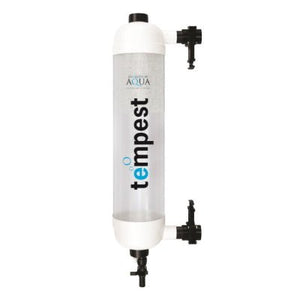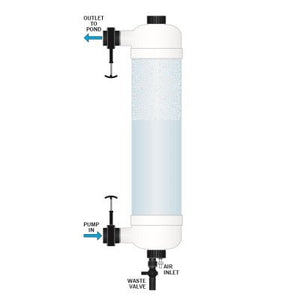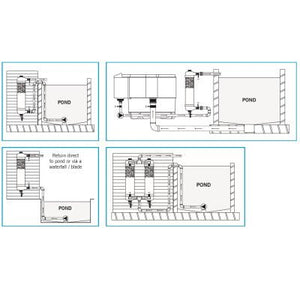Your Cart is Empty

The NEW Tempest Filter is an innovative polishing system for ponds. The Tempest Filter uses our latest filtration media, K+Media, to deliver crystal clear, healthy water.
Designed to be used in conjunction with any filtration system, the Tempest Filter offers additional mechanical and biological filtration. The Tempest Filter can be installed on a variety of set-ups and can be used on quarantine systems or as astandalone filter on smaller ponds up to 5,000 Litres / 1,100 Gallons.

The Tempest filter is easy to install and is simple and quick to clean, by way of a unique, patent pending air syphon design. During the cleaning process, air is drawn into the filter as it empties which causes the water to agitate, effectively cleaning the K+Media.






Using Evolution Aqua’s K+Media as the filter media, particles down to one micron can be filtered. On a single pass, testing has proven our media capable of removing all particles down to 25 micron when used at the optimum flow rate. Not only that, K+Media is the result of extensive research and development and is moulded with minerals for faster maturation times.

Evolution Aqua filter media has been independently tested by Cranfield University and the IFTS (Institut de la Filtration et des Techniques Séparatives). IFTS International Filter Testing Services is the international reference for solid-liquid separation. Founded in 1981, IFTS is an independently regulated, ISO 17025 accredited, laboratory and research center focusing on liquid filtration and separation science. IFTS quality management system is certified to ISO 9001:2015.

Water is pumped up through the Tempest Filter. The K+Media moves to the top of the filter, becoming a mechanical barrier that traps debris as it flows through the system. Waste is trapped in the K+Media until the cleaning cycle dislodges it and it gets flushed away.

The Tempest Filter can be cleaned in matter of minutes, by simply turning the pump off, closing slide valves and opening the waste valve tap.

| Max Pond Size | Inlet | Outlet | Drain Size | Max Flow Rate | Optimum Flow Rate | Volume of Water in Filter | Dimensions | Amount of K+Media Supplied |
|---|---|---|---|---|---|---|---|---|
| 5,000 Litres 1,100 UK Gallons 1,320 US Gallons |
1½” UK / USA 50mm EU |
1½” UK / USA 50mm EU |
1” UK / USA 32mm EU |
7,500 Litres/hr 1,650 UK Gallons/hr 1,980 US Gallons/hr |
5,000 Litres/hr 1,100 UK Gallons/hr 1,320 US Gallons/hr |
27 Litres 5.9 UK Gallons 7.1 US Gallons |
1055mm x 250mm x 205mm | 7 Litres |
There are a number of ways the Tempest Filter can be installed on your pond system. Below are some typical installation ideas.
PLEASE NOTE: The slide valves fitted to the Tempest Filter allow connection to 1½” pressure pipe. If installing the Tempest Filter using flexible hose you will need to fit a reducing sleeve (EA Code: M35-050) and a 1½” solvent weld stepped hosetail (EA Code: HOSETAIL15) inside each slide valve.
To allow the Tempest Filter to give the best performance, it is important that the flow rate is no more than the 5,000 litres per hour. Some of the installation examples show aby-pass that will enable you to increase the flow through the pond.
TYPICAL INSTALLATION WITH A GRAVITY-FED FILTER
You can install a Tempest Filter after a primary filter on a gravity-fed set-up, such as the Nexus+, and after a UV Clarifier, such as an evoUV. The slide valves on the Tempest Filter enable connection to 1½” pressure pipe.
The installation example shown below has a by-pass that will enable you to increase the flow through your pond while maintaining the optimum flow through the Tempest Filter. Installing ball valves on the pipe work will help you regulate the flow. The return from the Tempest can go back to the centre of your Nexus+ or back into the pond.

You can install a Tempest Filter on a pressurised system with a K1 Micro Bead, Nexus+, EazyPod. The slide valves on the Tempest Filter enable connection to 1½” pressure pipe.
The installation example shown below has a by-pass that will enable you to increase the flow through your pond while maintaining the optimum flow through the Tempest Filter. Installing ball valves on the pipe work will help you regulate the flow. The return from the Tempest and the K1 Micro Bead go back to the pond.

You can install a Tempest Filter on a quarantine system, or a standalone pond up to 5,000 litres, at the side of a pond or above the pond.
The slide valves on the Tempest Filter enable connection to 1½” pressure pipe. If installing the Tempest Filter using flexible hose you will need to fit a reducing sleeve (EA Code: M35-050) and a 1½” solvent stepped hosetail (EA Code: HOSETAIL15) inside each slide valve.

You can install a Tempest Filter on a skimmer line.
The slide valves on the Tempest Filter enable connection to 1½” pressure pipe. If installing the Tempest Filter using flexible hose you will need to fit a reducing sleeve
(EA Code: M35-050) and a 1½” solvent stepped hosetail (EA Code: HOSETAIL15) inside each slide valve.

On larger systems that require a higher flow rate, multiple Tempest Filters can be installed in a modular system. The slide valves on the Tempest Filter enable connection to 1½” pressure pipe. If installing the Tempest Filter using flexible hose you will need to fit a reducing sleeve (EA Code: M35-050) and a 1½” solvent stepped hosetail (EA Code: HOSETAIL15) inside each slide valve.
It is important that each Tempest Filter can be isolated using the slide valves so that cleaning can be carried out independently. Although on the installation diagram below we show two filters into one return line, independent return lines will allow you to observe the flow rate through both Tempest Filters and balance accordingly.



Plastic media, for use in biological pond filters - specifically in moving bed bio reactors, was pioneered by Evolution Aqua, some 20 years ago. In recent years, other plastic media have come onto the market, usually with the aim of trying to get more and more surface area. However, one drawback to using plastic media has always been the time it takes to establish a stable biofilm – essential for good filtration.
After many years of research, Evolution Aqua have now developed a new media that not only gives class leading surface area, but also overcomes the problem of long maturation times.
K+Media is designed and manufactured in the UK by Evolution Aqua. This advanced media, with its innovative design, and class leading surface area provides enhanced biological and mechanical filtration.
As Evolution Aqua extrude K+Media, Minerals and Enzymes are added to the raw material. The result of this process, unique to Evolution Aqua, is a filtration media that not only outperforms most of its competitors due to its large protected surface area, but also answers the problem of how to speed up the time taken to mature your filter.
During the extrusion process, Evolution Aqua add a range of minerals, along with magnesium, calcium, enzymes and salt to the raw material that is used to manufacture K+Media. The result means that K+Media will mature much faster than many other types of media.
- The addition of these minerals creates a rough surface on the media. This textured surface has a microscopic honeycomb of peaks and craters that allow waste particles to collect, and nitrifying bacteria to form.
- The minerals act as a food source for the bacteria, helping the bacteria to develop and multiply at a faster rate, further improving maturation times.
- Calcium alone has proven advantages for developing and maintaining effective bio-films.
- The enzymes that are added also help to make the media “sticky” so waste particles can adhere to media easier.
- Salt is added during the extrusion process, which is dissolved during the cooling process, leaving a rough surface on which bio-film can easily adhere.
With a new shape and profile, K+Media has also been designed to have an increased and class leading surface area, meaning an overall surface area of 1,350m2 per m3. More importantly for biological filtration, the protected surface area of K+Media is 1,025m2 per m3. This allows a stable bio-film to form and remain intact when used in moving bed biological filtration, as in the new Nexus+.



The shape of K+Media optimises the amount of “quiet zones” within the media where a stable bio-film can develop. Whilst K+Media keeps the integral profile of K1 Media at its core, there is an extra layer of cells and fins around the outside of each piece that enable microscopic organisms such as Rotifers and Vorticella to thrive. This is an additional benefit as competitor media do not have such “quiet zones” that would allow these higher lifeforms of filter feeders to develop. The bacteria and organisms that form within the bio-film ensure the media delivers optimum levels of biological filtration in the moving bed, which has been proven filtration technology for many years in the fishkeeping hobby.


